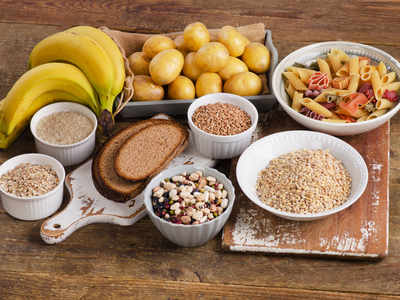- News
- lifestyle
- health-fitness
- diet
- What are digestible carbohydrates and are they any different from regular carbs?
Trending
This story is from March 25, 2020
What are digestible carbohydrates and are they any different from regular carbs?
The one thing most discussed about when we talk about any kind of diet is carbohydrates.

The most discussed term in our diet obsessed world is carbs. As per widespread claims, they are bad for your waistline and for your gut. But are they really the culprit? For that, we need to know what exactly are carbs and its component.
The amount of total carbs in a food corresponds to the sum of starches, sugars and dietary fibre. These different components can have a different effect on your blood sugar levels and overall health.
For example, grains such as bread, rice, pasta, breakfast cereals and baked goods and legumes such as beans and lentils contain a significant amount of carbohydrates per serving.On the other hand, fruits, dairy also provide you with considerable amounts of carbs per serving.
While talking about carbs, we all have heard of good carbs and bad carbs, but have you ever heard of digestible carbs? No? Don't worry, here is everything you should know.
Digestible carbs, also called available carbohydrates or net carbs, correspond to the fraction of the total carbohydrates that are digestible and available to provide energy to your body cells. Digestible carbohydrates correspond to the total of the grams of starches and sugars in a serving of foods. An easy way to count digestible carbs is by using the nutritional information available on food labels.
Subtract the grams of dietary fibre from the total carbohydrates in a serving of food. For example, one slice of bread contains 16 grams of carbohydrates and 2 grams of fibre. the digestible carbs would be 16 - 2 = 14 grams. '
Starch
Starch is composed of long chains of glucose or sugar. When digested, digestive enzymes break down the starches into glucose, which then enters your bloodstream and elevates your blood sugar levels. This starch is later converted from glucose to glycogen and the fat. Starch is mainly found in starchy vegetables like sweet potato, potato, grains and corns.
Sugar
Sugar in food is mainly disaccharides, which means two molecules of sugar bound together. Sugar rich foods are easily broken down and contribute to the rising blood sugar levels providing you with energy right after you eat them.
Dietary fibre
Dietary fibre is a part of total carbohydrates that are not easily broken or digested by your digestive enzymes. Fibre goes through your gastrointestinal tract and is eliminated in your faeces at the end of your intestinal transit. That is why fibre does not directly impact your blood sugar level, nor does it provide you with energy or calories. Some examples of fibre are fruits, vegetables, legumes, nuts, seeds and whole wheat bread/pasta.
The amount of total carbs in a food corresponds to the sum of starches, sugars and dietary fibre. These different components can have a different effect on your blood sugar levels and overall health.
For example, grains such as bread, rice, pasta, breakfast cereals and baked goods and legumes such as beans and lentils contain a significant amount of carbohydrates per serving.On the other hand, fruits, dairy also provide you with considerable amounts of carbs per serving.
While talking about carbs, we all have heard of good carbs and bad carbs, but have you ever heard of digestible carbs? No? Don't worry, here is everything you should know.
Digestible carbs
Digestible carbs, also called available carbohydrates or net carbs, correspond to the fraction of the total carbohydrates that are digestible and available to provide energy to your body cells. Digestible carbohydrates correspond to the total of the grams of starches and sugars in a serving of foods. An easy way to count digestible carbs is by using the nutritional information available on food labels.
Subtract the grams of dietary fibre from the total carbohydrates in a serving of food. For example, one slice of bread contains 16 grams of carbohydrates and 2 grams of fibre. the digestible carbs would be 16 - 2 = 14 grams. '
Starch
Starch is composed of long chains of glucose or sugar. When digested, digestive enzymes break down the starches into glucose, which then enters your bloodstream and elevates your blood sugar levels. This starch is later converted from glucose to glycogen and the fat. Starch is mainly found in starchy vegetables like sweet potato, potato, grains and corns.
Sugar
Sugar in food is mainly disaccharides, which means two molecules of sugar bound together. Sugar rich foods are easily broken down and contribute to the rising blood sugar levels providing you with energy right after you eat them.
Dietary fibre
Dietary fibre is a part of total carbohydrates that are not easily broken or digested by your digestive enzymes. Fibre goes through your gastrointestinal tract and is eliminated in your faeces at the end of your intestinal transit. That is why fibre does not directly impact your blood sugar level, nor does it provide you with energy or calories. Some examples of fibre are fruits, vegetables, legumes, nuts, seeds and whole wheat bread/pasta.
End of Article
FOLLOW US ON SOCIAL MEDIA









